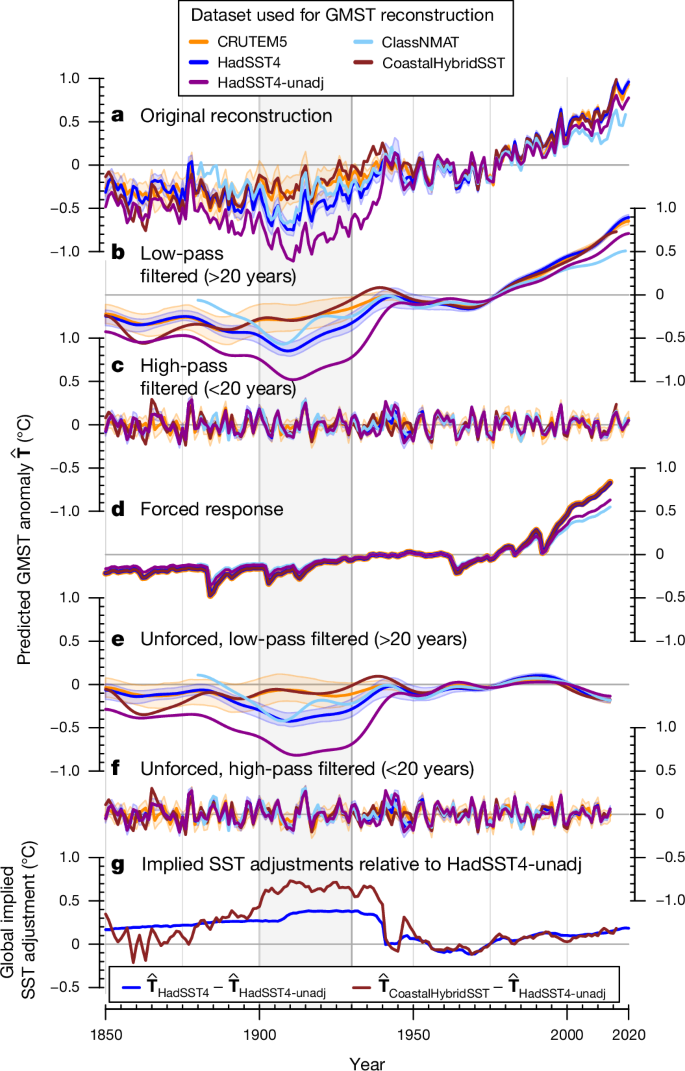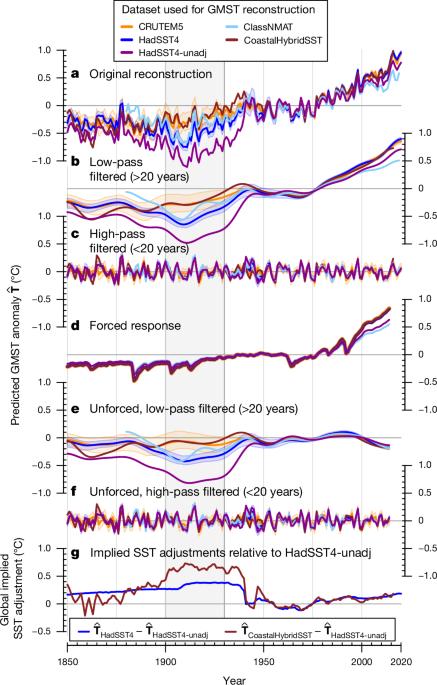二十世纪初海洋表面温度观测的冷偏差
IF 50.5
1区 综合性期刊
Q1 MULTIDISCIPLINARY SCIENCES
引用次数: 0
摘要
观测到的温度记录结合了海面温度和陆地近地面气温,对于了解气候变异和变化至关重要1,2,3,4。然而,由于测量技术和实践的变化、部分文献5,6,7,8 和不完整的空间覆盖9,早期的全球平均表面温度记录并不确定。在此,我们根据海洋或陆地数据对全球平均表面温度的独立统计重建结果表明,现有的 20 世纪早期(1900-1930 年)海洋温度估计值过低。基于海洋的重建平均比基于陆地的重建低约 0.26 °C,尽管在所有其他时期都有很高的一致性。海洋低温异常是非强迫性的,气候模式的内部变异性无法解释观测到的陆地-海洋差异。基于归因、时间尺度分析、沿岸网格单元和古气候数据的一些证据支持 20 世纪初观测到的全球海面温度记录存在严重的寒冷偏差这一论点。尽管对 19 世纪中叶以来全球变暖的估计没有受到影响,但修正海洋低温偏差将使 20 世纪初的变暖趋势更加温和10 ,降低从仪器记录中推断出的十年尺度变率估计值3 ,并使模拟和观测到的变暖之间的一致性比现有数据集所显示的更好2。本文章由计算机程序翻译,如有差异,请以英文原文为准。


Early-twentieth-century cold bias in ocean surface temperature observations
The observed temperature record, which combines sea surface temperatures with near-surface air temperatures over land, is crucial for understanding climate variability and change1–4. However, early records of global mean surface temperature are uncertain owing to changes in measurement technology and practice, partial documentation5–8, and incomplete spatial coverage9. Here we show that existing estimates of ocean temperatures in the early twentieth century (1900–1930) are too cold, based on independent statistical reconstructions of the global mean surface temperature from either ocean or land data. The ocean-based reconstruction is on average about 0.26 °C colder than the land-based one, despite very high agreement in all other periods. The ocean cold anomaly is unforced, and internal variability in climate models cannot explain the observed land–ocean discrepancy. Several lines of evidence based on attribution, timescale analysis, coastal grid cells and palaeoclimate data support the argument of a substantial cold bias in the observed global sea-surface-temperature record in the early twentieth century. Although estimates of global warming since the mid-nineteenth century are not affected, correcting the ocean cold bias would result in a more modest early-twentieth-century warming trend10, a lower estimate of decadal-scale variability inferred from the instrumental record3, and better agreement between simulated and observed warming than existing datasets suggest2. Independent statistical reconstructions of the global mean surface temperature from either ocean or land data show that existing estimates of early-twentieth-century ocean surface temperatures are too cold.
求助全文
通过发布文献求助,成功后即可免费获取论文全文。
去求助
来源期刊

Nature
综合性期刊-综合性期刊
CiteScore
90.00
自引率
1.20%
发文量
3652
审稿时长
3 months
期刊介绍:
Nature is a prestigious international journal that publishes peer-reviewed research in various scientific and technological fields. The selection of articles is based on criteria such as originality, importance, interdisciplinary relevance, timeliness, accessibility, elegance, and surprising conclusions. In addition to showcasing significant scientific advances, Nature delivers rapid, authoritative, insightful news, and interpretation of current and upcoming trends impacting science, scientists, and the broader public. The journal serves a dual purpose: firstly, to promptly share noteworthy scientific advances and foster discussions among scientists, and secondly, to ensure the swift dissemination of scientific results globally, emphasizing their significance for knowledge, culture, and daily life.
 求助内容:
求助内容: 应助结果提醒方式:
应助结果提醒方式:


